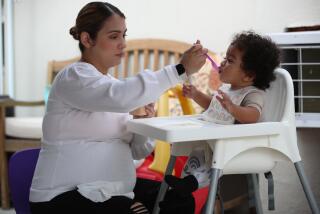Use Public Schools for Learning, Not for Social Welfare Programs : Traveling down the path of campus-based clinics risks subjecting children to a healthy but hopeless future.
- Share via
The Orange Unified School District Board of Trustees recently adopted a policy that will ban “permanent school-based clinics on school campuses.” The vote is seen as a hollow victory for social conservatives because of the inclusion of the word “permanent,” but the debate over school-based clinics will grow.
Originally, critics accused the board of wanting to deprive needy children of food, clothing, dental, medical and social services. However, the debate was never over breakfast or lunch programs, immunization programs, charity events, free dental programs, or any other programs in which the provider comes to the campus before or after hours, and has no facilities that remain on the premises.
The issue was always centered on banning school-based clinics that provide medical, psychological and social services through foundational and governmental grants. It should be noted that this ban does not pertain to any services that are provided by the school district, which would be overseen by the school board and paid for through the general fund.
On the surface, school-based clinics sound like a good idea. They are convenient, they cost students no money as private and government grants pick up the tab, and they address student needs quickly and efficiently. But many concerned citizens and school board members see long-range problems that get scant attention in the mainstream press.
First, medical and social needs of children are best addressed by parents, not by foundations and government agencies that set up shop at the public schools. It should be noted that these services already are provided by outside agencies. Just because children don’t receive these services at schools does not mean they cannot receive services elsewhere.
But when it becomes too easy for parents to abdicate their responsibilities because someone at school will provide for their children, it teaches children to depend on government for their well-being, and it undermines the family structure.
Second, the emphasis on school-based clinics temporarily takes the focus of the failures of the public school system off the educational establishment and puts that focus on the “whole child.” The new reason why “Johnny can’t read” is because all of his social needs haven’t been met.
Third, social engineers have made no secret over the years that they would like to leave child rearing to the government. School-based clinics can provide the structure necessary for an increased role in government rearing of children, because parents aren’t present at the school site, and parents have little understanding of exactly what goes on in these clinics.
Fourth, school-based clinics and all of the social programs associated with them are designed to address everything except reading, writing, arithmetic, history and science, etc., which are the very reasons why we have public schools in the first place. Without a strong educational foundation, our children simply don’t have a chance to succeed in the increasingly competitive world economy.
Public schools already offer a host of programs like Project Self-Esteem, Earth Day Week, Multicultural Week, drug awareness programs, even Christian Release Time and who knows what else. While all of these programs appear to offer some benefits to our children, they all have one thing in common. They take away from what is left of instructional time. A new social welfare agenda will not add to the instructional day, but rather will detract from it.
Fifth, by setting up these social welfare programs at school sites, we are turning our teachers into social workers. This is not why teachers got into the profession, and it may be a good reason for them to want to leave.
It is noteworthy to mention that as government agencies are attempting to slim down welfare payments on the front end, they are playing a bigger role through the back door by subsidizing the public schools with “help money” for needy children. The public has acquired a jaundiced view of welfare moms and dads, although they have a soft spot in their hearts for the victimized children. But the question of the role of public education remains. Do we allow our public schools to become social welfare clinics; do we turn our teachers into social workers; and do we attempt to make parents irrelevant?
Perhaps what is needed is a national debate as to what exactly the role of public education should be. Do we emphasize a curriculum of excellence in education and help those less fortunate children to the best education possible? Or do we turn public schools into social welfare institutions and subject these children to a healthy but hopeless future, which is exactly what we will get if we travel down the path of school-based clinics.
If we choose the latter, then we can expect parents who care about their children’s education to flee the public schools in droves, and place their children in private schools at any cost. State legislatures will be forced to respond to the financial needs of parents who have left the government-run schools in large numbers, with some sort of voucher assistance, and ultimately making public education obsolete. Whatever the final outcome, public education is truly at a crossroads.
More to Read
Sign up for Essential California
The most important California stories and recommendations in your inbox every morning.
You may occasionally receive promotional content from the Los Angeles Times.













